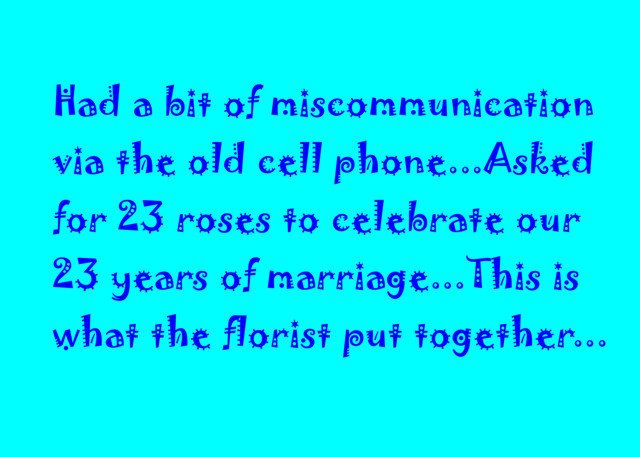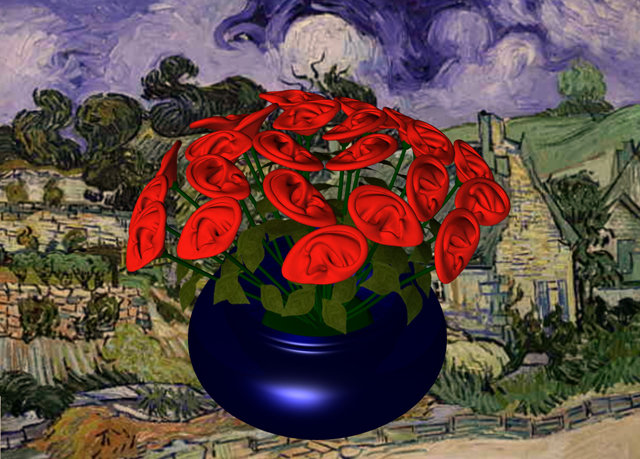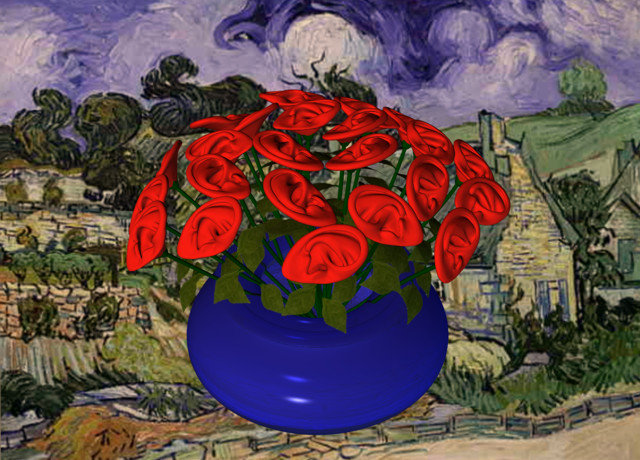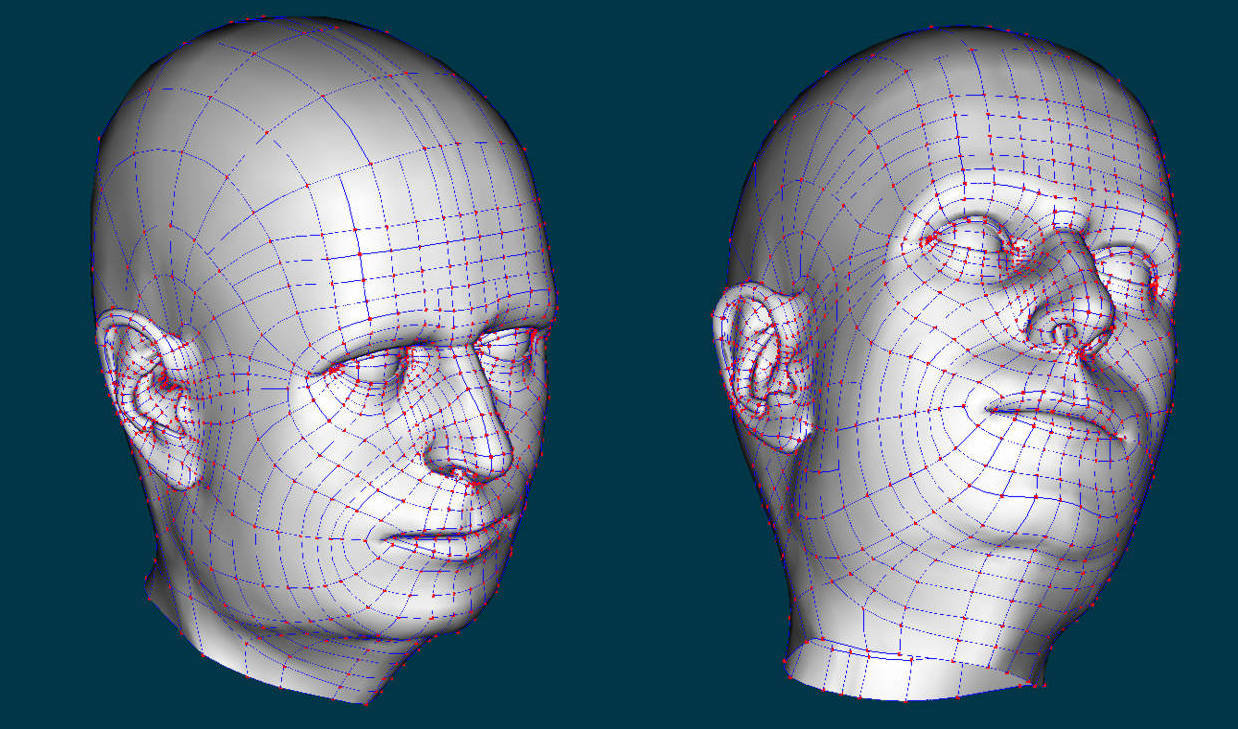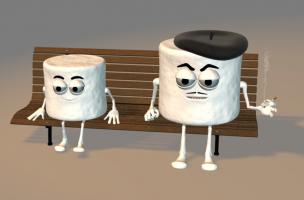-
Posts
907 -
Joined
-
Last visited
Content Type
Profiles
Forums
Events
Everything posted by williamgaylord
-
Thanks for the compliments! AAC! I was so focused on the video the audio coding options slipped my mind! (Easy done, given the tiny dimensions of my mind!) Yes, I do have Quicktime Pro so I should give that a whirl. Thanks for the suggestion. Bill Gaylord
-
A couple of hints: The painting in the background is a Van Gogh...and you are more likely to find wax than pollen or nectar in these fowers... (you probably figured it out already, I'm sure) I've attached the front of the card, which makes the visual pun a lot more obvious. ...and yes, you could put your finger in it! Thanks! My wife loved the card and we had a wonderful night out! (And yes, we've had 23 _ears [sic] together!) Bill Gaylord
-
-
My wife and I are celebrating our 23rd anniversary today, so I'm created a bouquet for my wife. Actually this will be part of a card I'll be printing shortly. Yes, I am indeed prone to bad puns! But fortunately my wife has the same brand of humor. The card will explain that the result is due to a bad cell phone connection when I called the florist... Bill "Bad Pun! Bad Pun!" Gaylord
-
This has been on AM Films for some time, but I recently updated it to include the title and credits. (This expanded it to 6M instead of the posted 4M, so be warned.): Marshmallow Lecter It features a marshmallow character I designed for a series of short films in the works I call the "Marshmallow Safety Films". Being rather vulnerable, it's rather easy to invent many kinds of humorous "accidents" for them to experience. Not much action in this one. More of an exercise in lip syncing, based on Jason Osipa's excellent methods from his book "Stop Staring--Facial Modeling and Animation Done Right". (I very highly recommend this book! A must have for anyone really serious about learning facial animation.) Enjoy! Bill Gaylord
-
If you want a quick peek at what I look like before I get around to applying decals just click on my forum name and check out the photo on my profile. I would be glad to add it to the Extras DVD. I'll also donate the both the regular and "orc" ears as well. Bill
-
Still needs plenty of tweaking, but here it is attached to the ears. Ears and face are OK, but the shape of the head isn't quite right, especially at the back. The problem stems from side and frontal rotos that don't match because the camera perspective causes relative distortions. I take it the best way to prepare rotoscope photos is to use a telephoto lense with a long focal length. So with a mirror (or two), I'll make adjustments. Ears are my own design (with plenty of inspiration from Yves Poissant and Mark Strohbehn). The face modeling follows Bill Young's "Model a Face" tutorial CD for the most part, with a few changes mainly in how the ears and face connect. Bill
-
You have such a unique and very entertaining style. Really enjoyed this one! I enjoy your ever present decorative flair, too.
-
I like the look, but technically speaking your ocean waves would be sunamis that would dwarf Mount Everest. Depends on whether you want a realistic look or an artistic fantasy look.
-
Very nice work! Very believable, natural (but creepy) form.
-
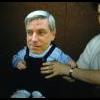
'Bubblegum Crisis' on A:M Films
williamgaylord replied to Rodney's topic in Work In Progress / Sweatbox
I'm unable to view it either. I have Quicktime 6.5.2. I would upgrade to 7, but I'd have to pay for the Pro upgrade again. (If I need to, I will.) Anybody else have the same version that can play it? At the first attempt I got the error message that the "required decoder was not available on the Quicktime site". Bill Gaylord -
Thanks. With practice I should get better at it. This is my first try, so it is very much a learning experience. I'm following Bill Young's "Model a Face" tutorial, so you might see some of his style reflected in my head. I'm amazed at the elegance and efficiency of some of the work posted and aspire to approach that kind of skill some day. There are some really talented people out there, most of whom are very helpful and generous. Thanks for the encouragement.
-
I did say that is was an idealized portrait... Have you seen my baby picure?Baby Pic Since I plan to use this to hone my facial rigging and animation skills, I may wind up removing the hooks. Thanks for the suggestion!
-
This is quite interesting. I'm not familiar with the term IBL. Are you saying you are creating the illusion of a surrounding image field that simulates a 3D point of view that can be rotated as though you were in the room looking around? BTW, I first caught the title out of the corner of my eye and misread it as "Hoovering coin", promting a vivid image of a coin vacuuming the appartment. Nice work! Bill Gaylord
-
Thought I'd finally take a crack at modeling a realistic head to go with the ears I made earlier. This is a self portrait (egomaniacal person that I am). I made ears during a post debating what is the most difficult body part to model. (The "ears have it" in this case.) The ear models (I made an elf/orc version, too) are still available if anybody needs ears for their own model. Ears Here's the face to go with the ears (idealized of course--"Isn't he so handsom! Gaffaw, gaffaw..."). Any suggestions for improvement--for the model that is, not plastic surgery for myself--are quite welcome. Thanks!
-
Here is a start on the Mascot of my trademark Arty-Joke Productions. It will be an artichoke, of course. (I can hear some of you moaning!) He'll be a stand-up comic when I finish with him. Any constructive criticism is welcome. Thanks! Bill Gaylord
-
Wow! Will have to catch up to V13 soon! Bill Gaylord
-

had to play with the alpha new displacement
williamgaylord replied to johnl3d's topic in Work In Progress / Sweatbox
That is pretty amazing! That could probably be used for an interesting flame effect with some tweaks. -
I want one of those! That's the kind of car I'd like to drive! Do you ever sleep, Stian? I'm amazed at how you seem to crank out these amazingly detailed models seemingly so quickly. Nice work! Bill Gaylord
-
Only just caught up with this thread. Brutally funny!! You guys are amazing! Bill Gaylord
-

Marshmallow Safety Film
williamgaylord replied to williamgaylord's topic in Work In Progress / Sweatbox
I just uploaded more complete copies of the Marshmallow Lecter movie, complete with title, credits, and stereo sound! Enjoy! (Same link posted earlier: post #85) Bill Gaylord -

Marshmallow Safety Film
williamgaylord replied to williamgaylord's topic in Work In Progress / Sweatbox
I hope it will be quite a bit more awsome when I get the episode animated. Anybody out there know how to get a character to blow smoke? Need to teach the angry marshmallow how to smoke. Thanks! Bill Gaylord -

Marshmallow Safety Film
williamgaylord replied to williamgaylord's topic in Work In Progress / Sweatbox
OK, it's back to work on this project! No promises about completion time, though. Here are the two characters of the first episode of the Marshmallow Safety Films. I apologize for the stereotype "French" marshmallow, if anybody is offended by such stereotypes. I plan to do the dialog in French, with English subtitles. The angry marshmallow will be complaining about being called a "mere marshmallow" by some snooty "high class" confections, while smoking up a storm. Bill Gaylord -
Hairy Kow, Batman! This must be the ice age kow...a wooly bovine? Bill Gaylord
-
Good choice for the song. More of a sultry amazon voice which fits the model better than this petite sex kitten voice (Rrrrrrr!): Eartha Kitt singing Santa Baby!









